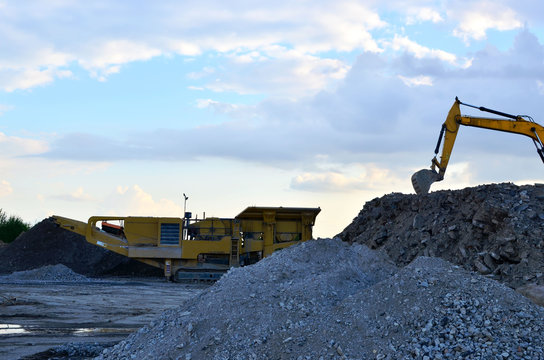Cement manufacturing is a complex and intricate process that is pivotal to the construction industry. At the heart of this process lies the crucial step of crushing, where raw materials are transformed into fine powders suitable for further processing. This article delves into the fascinating journey of crushing in the cement production line, focusing on the role and functioning of concrete crushers.
Understanding the Importance of Crushing in Cement Production
Cement production involves several stages, from the extraction of raw materials to the grinding and blending of these materials to produce cement. The initial phase of crushing raw materials is critical as it determines the quality and consistency of the final product. The primary purpose of crushing in cement production is to reduce large rocks and raw materials into smaller, manageable sizes for further processing.
The Role of Crusher Cement in the Crushing Process
Crusher cement, a term often used to describe the equipment used in the first stage of the crushing process, plays a vital role in the cement manufacturing process. This machinery is designed to handle large chunks of raw materials such as limestone, clay, and iron ore, breaking them down into smaller pieces. The crusher cement’s efficiency significantly impacts the smoothness of subsequent processes in the cement production line.
Types of Cement Crushers and Their Functions
In the realm of cement production, various types of cement crushers are employed, each serving a specific purpose:
- Jaw Crushers: These are used for the primary crushing of hard and abrasive materials. They work by compressing the material between a stationary and a moving jaw.
- Gyratory Crushers: Similar to jaw crushers, gyratory crushers are also used for primary crushing. They are particularly effective for hard and abrasive materials.
- Cone Crushers: Cone crushers are used for secondary crushing. They reduce the size of the material further, preparing it for the final stage of grinding.
- Impact Crushers: These are used for both primary and secondary crushing. They are particularly useful for softer materials.
- Hammer Crushers: Employed for the secondary crushing of materials with medium hardness, hammer crushers are known for their high-speed impact on materials.
The Process of Crushing in Cement Production
The process of crushing in cement production involves several steps:
- Feeding: Raw materials are fed into the crusher cement.
- Crushing: The crusher breaks down the large chunks into smaller pieces. The type of crusher used depends on the nature of the material.
- Transportation: The crushed material is then transported to the next stage of production.
- Screening: The crushed material is screened to separate fine from coarse particles.
- Re-crushing: Larger particles are sent back to the crusher for further crushing.
Innovations in Concrete Crushers
Concrete crushers, a subset of cement crushers, are specifically designed to deal with concrete material. These crushers have evolved over the years, incorporating advanced technologies to increase efficiency, reduce energy consumption, and minimize environmental impact. Modern concrete crushers are equipped with features such as automatic gap adjustment, improved wear-resistant materials, and better dust control systems.
Environmental Considerations and Sustainability
Environmental sustainability in cement-crushing processes is paramount, given the typically high energy consumption and resultant emissions. Crusher cement and concrete crushers are increasingly designed to be environmentally conscious, focusing on reducing carbon footprints. These machines are equipped with the latest technology to minimize energy usage and optimize efficiency. For instance, modern cement crushers are fitted with systems that recirculate air and reduce particulate emissions, addressing the industry’s pressing concern of dust pollution.
Advancements in materials and design also contribute to sustainability efforts. Wear-resistant materials prolong the life of concrete crushers and decrease the frequency of replacements, leading to less waste and reduced industrial demand. Moreover, the integration of noise-dampening technology helps mitigate the sound pollution that these heavy machines generate, contributing to a more sustainable work environment.
The move towards sustainability in the crushing phase of cement production also includes the implementation of better energy management systems, which allow for the precise control of power consumption, leading to significant energy savings. Overall, the cement industry’s focus on environmental considerations is paving the way for a more sustainable future in construction materials manufacturing.
Safety Practices in Cement Crushing Operations
Cement crushing operations pose various occupational hazards, including dust exposure, noise pollution, and potential machinery accidents. To mitigate these risks, rigorous safety measures and protocols are implemented. Dust suppression systems and personal protective equipment (PPE), such as respirators, ear protection, and safety goggles, are essential to protect workers from inhalable particles and high decibel levels. Furthermore, the areas around crusher cement and concrete crushers are demarcated with clear signage to maintain a safe perimeter for non-operational staff.
Training is a critical component of safety in cement-crushing operations. Crusher operators are thoroughly educated on machinery handling, emergency response procedures, and best practices for routine maintenance checks. These training programs are often reinforced through regular drills and refresher courses, ensuring safety remains at the forefront of all operational activities. Such protocols not only safeguard the health and well-being of employees but also provide the smooth and efficient running of crushing operations.
The Future of Crushing in Cement Production
The future of crushing in cement production is geared towards technological innovation, sustainability, and efficiency. Advances in predictive maintenance will revolutionize how crusher equipment is managed by forecasting potential malfunctions and scheduling timely repairs, thus minimizing downtime and maintaining consistent output. Incorporating smart crushers with IoT capabilities will enable real-time monitoring of operations, optimize performance, and reduce energy consumption.
Artificial intelligence (AI) and machine learning algorithms are set to enhance the precision of crushing processes, allowing for finer control over particle size distribution and cement quality. These technologies will lead to a more customized approach, catering to specific construction requirements. Additionally, the ongoing development of environmentally friendly crushers that reduce carbon emissions and recycle concrete waste will contribute to a more sustainable cement industry. As these technological advances take hold, the cement production landscape will evolve towards a more efficient, less environmentally taxing, and highly automated future.
Final Words
The crushing process in cement production is a critical and complex operation that significantly influences the quality of the final product. Each piece of equipment plays a vital role in transforming raw materials into the fine powder necessary for cement production, from crusher cement to concrete crushers. As technology advances, these processes are becoming more efficient, sustainable, and environmentally friendly, contributing to the overall efficiency and sustainability of the cement industry.




